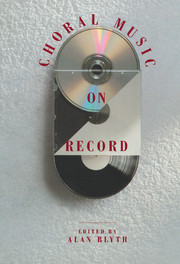Book contents
- Frontmatter
- Contents
- Preface
- Monteverdi: Vespers (1610)
- J.S. Bach: St John Passion
- J.S. Bach: St Matthew Passion
- J.S. Bach: Mass in B Minor
- Handel: Messiah
- Mozart: Requiem Mass
- Haydn: The Creation
- Haydn: The Seasons
- Beethoven: Missa Solemnis
- Mendelssohn: Elijah
- Rossini: Stabat mater Petite messe solennelle
- Berlioz: Grande Messe des Morts Te Deum L'Enfance du Christ
- Verdi: Requiem Mass
- Brahms: A German Requiem
- Fauré: Requiem
- Elgar: The Dream of Gerontius
- Walton: Belshazzar's Feast, Tippett: A Child of Our Time, Britten: War Requiem
- Stravinsky: The Wedding Symphony of Psalms
- Janáček: Glagolitic Mass
- Discographies
- Index
J.S. Bach: Mass in B Minor
Published online by Cambridge University Press: 02 December 2009
- Frontmatter
- Contents
- Preface
- Monteverdi: Vespers (1610)
- J.S. Bach: St John Passion
- J.S. Bach: St Matthew Passion
- J.S. Bach: Mass in B Minor
- Handel: Messiah
- Mozart: Requiem Mass
- Haydn: The Creation
- Haydn: The Seasons
- Beethoven: Missa Solemnis
- Mendelssohn: Elijah
- Rossini: Stabat mater Petite messe solennelle
- Berlioz: Grande Messe des Morts Te Deum L'Enfance du Christ
- Verdi: Requiem Mass
- Brahms: A German Requiem
- Fauré: Requiem
- Elgar: The Dream of Gerontius
- Walton: Belshazzar's Feast, Tippett: A Child of Our Time, Britten: War Requiem
- Stravinsky: The Wedding Symphony of Psalms
- Janáček: Glagolitic Mass
- Discographies
- Index
Summary
The Mass in B Minor is best thought of as an anthology, a collection of his ‘best’ sacred music assembled by Bach in the last years of his life. During the 1730s and 1740s, Bach put together several such Kunstbücher (literally, books of art); the most widely known are The Art of Fugue, the four volumes of the Clavier Übungen, and the 17 Chorales of Different Kinds. Some of these anthologies Bach either published or intended to publish; others, like the Mass, he did not. These less ‘commercial’ distillations he left to his heirs, physical and spiritual, to preserve and disseminate to those who were interested.
With the exception of the opening four measures of the first Kyrie, it seems that every movement of the Mass is a reworking of an existing vocal composition, either sacred or secular. At least one such movement, the Crucifixus, dates from the Weimar years. The Kyrie and Gloria were put together in 1733, as a presentation piece to the Elector of Saxony and King of Poland, from whom Bach sought, ultimately successfully, the professionally and socially invaluable position of Court Composer. The Sanctus is a careful and subtle revision of the setting of the text that he wrote for performance in Leipzig on Christmas Day, 1723. The Symbolum Nicenum [the Credo section] and the concluding movements of the Mass were added in the late 1740s, when both Bach's eyesight and his health were failing.
The Kyrie, the Gloria, and the Symbolum Nicenum are all in five voices; the texture expands to six voices in the Sanctus and eight in the Osanna.
- Type
- Chapter
- Information
- Choral Music on Record , pp. 46 - 60Publisher: Cambridge University PressPrint publication year: 1991



